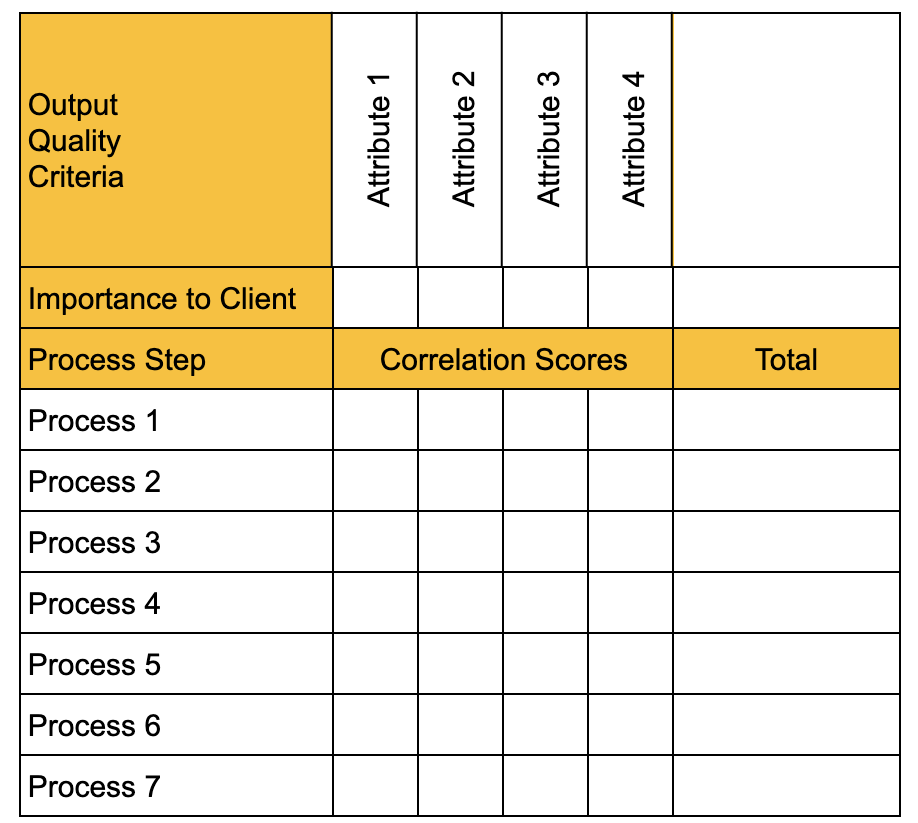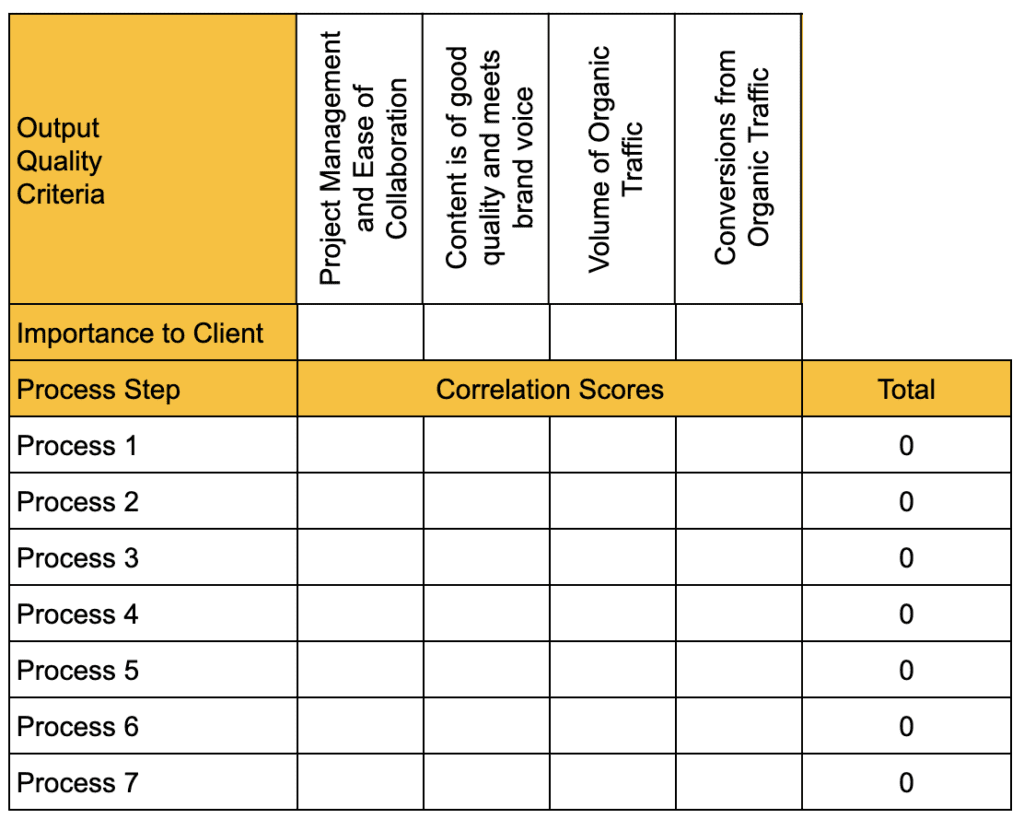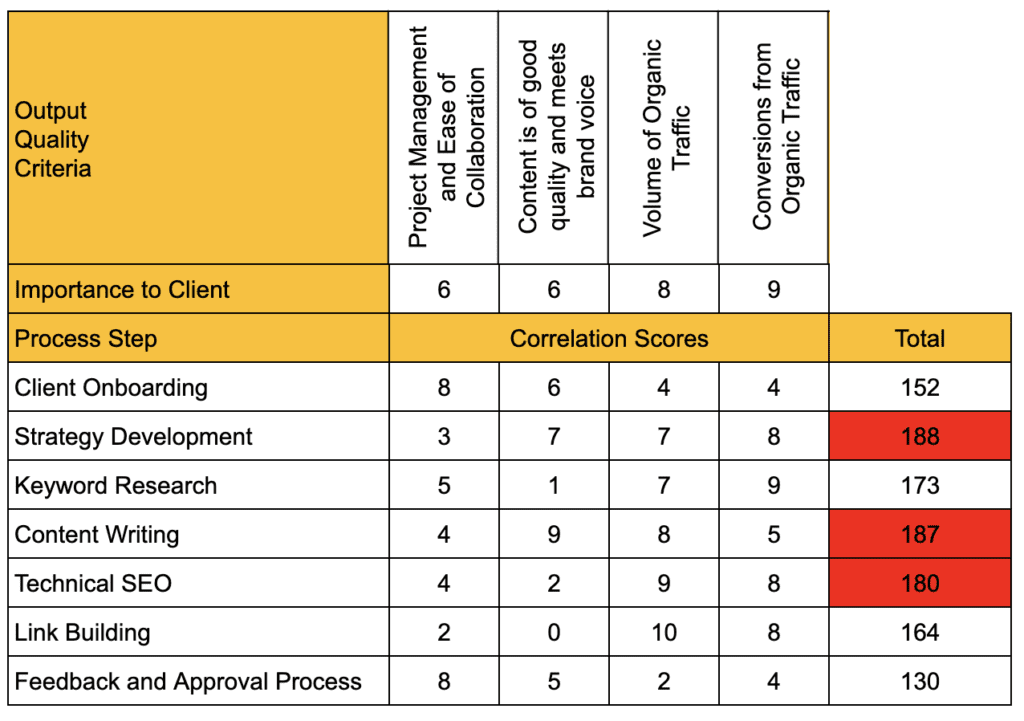- Collect the quality criteria of your service that are important for client experience (or any other thing that you want to improve, like cost structure)
- Define how important each criteria is
- Collect your key processes
- Define how much each process contributes to each criterion
Let’s look at each step.
FIND A FREE TEMPLATE FOR THE CAUSE AND EFFECT MATRIX AT THE END OF THIS ARTICLE.
The Cause-and-Effect Matrix
The idea of the Cause-and-Effect Matrix is to provide a structured view on the importance of your processes for client experience or any other dimension. For the sake of readability, we’ll focus on client experience in this article.
Collect the Quality Criteria of your Offering
In the first step, you need to define what’s important for client experience. Write down the aspects of your service that are important to your clients.You might have a good idea already what those are. If you don’t, here are a few ways to collect them.
Ask your clients
The next time you speak with your clients, ask them:- What aspect of our service and collaboration is really important for you?
- What would you wish for?
- What don’t you like?
Send a questionnaire
While asking is the most efficient way, you can also use a form or questionnaire to get the responses. Keep the questionnaire qualitative and open in the first step. You’re trying to collect information, not confirm what you already think you know.Ask your team
Everyone in your team who has direct or indirect contact with clients will be able to tell you what they value. Beyond your core delivery and account management people, also include admin functions with client contact (e.g. book-keeping).Add criteria to the Cause-and-Effect-Matrix
Add the results to your Cause-and-Effect-Matrix, at the top. Here’s an example for an SEO agency.- Project management and ease of collaboration
- Content is of good quality and meets brand voice
- Volume of organic traffic
- Conversions from organic traffic

Determine How Important Quality Criteria are
Now you know which criteria matter. The next thing you want to find out is how important they are.
If you already have a good understanding, and feel confident that you know your clients well, fill out the weighting yourself: Add a number from 0-10 to each column, describing how important the criteria are for overall client satisfaction.
We recommend sending your clients a quick survey, asking them to rate the importance of each of the items on a scale of 1-10.
Note that the result can vary significantly between clients. Your goal is to find the weighting that’s most representative of the clients you work with most often/want to work with.

Collect your core processes
In the next step, collect your core processes. Think about all the major tasks that need to happen when you deliver your service.
Also include supporting tasks that have direct client interaction, as they might impact experience.
At this stage, don’t get too granular just yet. Once you’ve completed the Cause-and-Effect-Matrix, you’ll know where to deep dive.

Determine How Each Process Contributes to Your Quality Criteria
As a last step, work through your processes and determine how much they influence your quality criteria.
Use numbers from 0 (no correlation) to 10 (1:1 correlation) for this so-called correlation score.
In the Total Column, calculate the sum product between the impact of the process and the weighting of the criterion.
This will tell you how much each process really contributes to client experience. The results might surprise you.

In general, it’s important to be diligent when defining criteria, weighting and correlation scores. Once defined, try to accept the result as what it is. Resist the temptation to tweak the numbers until you get the result you expected.
If just as a thought experiment, assume that the results are accurate. Think through how to improve the highest-scoring processes.
The Cause-and-Effect-Matrix is a powerful tool to determine what part of your company’s work really drives value for your client.
Once you know which processes to look at, use mapping and
root cause analysis to improve them.